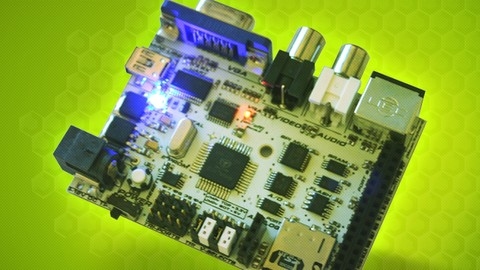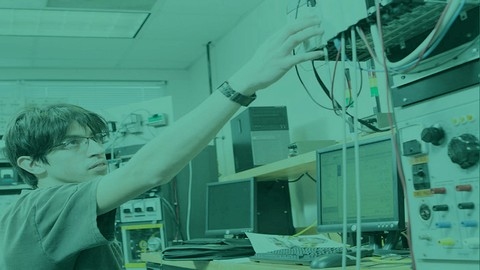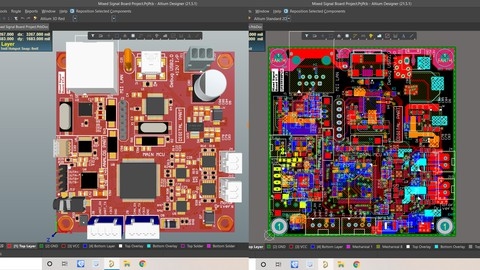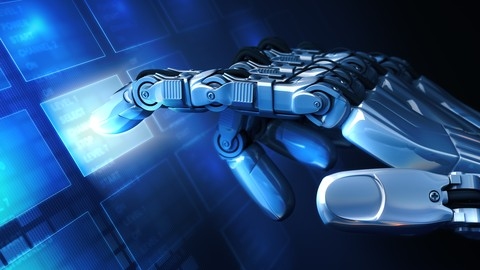Crash Course Electronics and PCB Design
This massive course covers both the theory and practical aspects of electronics and PCB design in incredible depth.
The syllabus is structured to start from the basics of electronics components like resistors, capacitors, and inductors.
It then builds up layer by layer, covering analog and digital circuit analysis techniques, semiconductor devices like diodes and transistors, digital logic design, programmable logic, microcontrollers, and finally printed circuit board (PCB) design and manufacturing.
The unique strength of this course lies in its hands-on approach.
You won’t just learn the theory - the lectures are accompanied by numerous bench experiments, circuit simulations, and three full PCB design projects.
These allow you to apply the concepts practically and develop a deep understanding from the ground up.
The syllabus covers fundamental topics like Ohm’s law, Kirchhoff’s laws, Boolean algebra, and AC/DC circuit analysis.
It then dives into advanced subjects like complex impedance, phasor analysis, operational amplifiers, transistor amplifiers, logic families, programmable logic, and much more.
The course even touches on niche areas like conductive inks and hacking techniques.
What sets this course apart is the end-to-end PCB design process you’ll go through for three projects - a magic wand, a 555-based organ, and an Arduino-based “SimonDuino” game console.
You’ll learn how to install and use the CircuitMaker software, do schematic entry, component placement, PCB routing, generate manufacturing files, and more.
This is invaluable practical experience that most electronics courses lack.
The syllabus is very comprehensive, yet the lecture descriptions suggest the instructor will explain concepts clearly and gradually build up your knowledge.
There are also many “bonus lectures” that cover random interesting electronics topics like motor drivers, audio amplifiers, power supplies, test equipment selection, and even some career advice.
The course combines rigorous electronics theory with extensive practical PCB design experience.
You’ll develop a strong foundation while learning directly applicable skills for building real-world electronics products.
The hands-on approach and project-based learning make this a standout option among electronics courses.
Electricity & electronics - Robotics, learn by building
The course covers the fundamentals of electricity and electronics, starting from the basics of DC and AC electricity.
You will learn about components like resistors, capacitors, diodes, LEDs, and microchips.
The course takes a hands-on approach, guiding you through building circuits on a breadboard and using tools like multimeters.
One of the key focuses is understanding how to read schematic diagrams and then building the circuits they represent.
You’ll learn about essential concepts like Ohm’s law, voltage dividers, and pulse width modulation (PWM).
The course also covers more advanced topics such as transistor amplifiers, operational amplifiers (op-amps), and their applications in areas like audio amplification and biofeedback systems.
Robotics is a significant part of the curriculum.
You’ll learn about components crucial for robotics, such as servo motors, motor control circuits (including H-bridges), and continuous rotation servos.
The course even delves into building your own servo motors and hacking existing ones for specific purposes.
Power supplies, an essential aspect of electronics, are covered in detail.
You’ll learn about transformers, voltage regulators, and even salvaging parts from scrap electronics.
The course also touches on high-power transmission, which is crucial for applications like electric vehicles and mobile robots.
Throughout the course, you’ll encounter bonus lessons that address common student questions, provide additional explanations, or explore related topics like comparators and hysteresis.
The course includes quizzes to test your understanding of the material covered.
You’ll gain hands-on experience building circuits and a solid theoretical foundation to understand how electronic components work together.
The Complete Electronics Course 2024: Analog Hardware Design
You will start by learning about the history of electricity and how it led to the development of electronic devices.
The course then dives into the basics of electricity, including atoms, electric charge, conductors, and insulators.
Next, you will learn how to use a circuit simulator, which is an essential tool for understanding and designing electronic circuits.
The course covers the fundamentals of voltage, current, resistance, and Ohm’s law, as well as direct current (DC) and alternating current (AC) circuits.
You will then explore various electronic components, such as resistors, capacitors, inductors, diodes, and transistors.
The course explains how these components work, how to calculate their values, and how to use them in circuits.
You will also learn about Kirchhoff’s circuit laws, which are essential for analyzing and designing complex circuits.
The course covers several important topics, including electric power, filters, radio and signal modulation, and various types of circuits, such as rectifiers, amplifiers, and oscillators.
You will also learn about operational amplifiers (op-amps) and their applications in arithmetic circuits, precision rectifiers, and other common circuits.
Additionally, the course covers linear voltage regulators, MOSFETs, and DC-to-DC switching converters, which are essential for power supply design and voltage regulation.
Throughout the course, you will have the opportunity to apply your knowledge through quizzes and simulations, ensuring that you understand the concepts thoroughly.
The Complete Basic Electricity & Electronics Course
You’ll start by learning about electric current, atoms, electrons, and the conventional direction of current flow.
This lays the foundation for understanding voltage, which is explained through the concepts of work, potential energy, electric fields, and electric potential energy.
The course also covers different types of signals, including periodic, analog, and digital signals.
Next, you’ll dive into batteries, exploring how they work, the chemical reactions involved, and how to calculate their energy capacity.
The course then moves on to resistors, covering Ohm’s law, resistance calculations, resistor types (through-hole and surface mount), and the resistor color code.
You’ll also learn about potentiometers, which are variable resistors.
The course dedicates a section to electric power, explaining its relationship with energy and how to calculate power dissipation in resistors.
You’ll also learn about capacitors, their structure, energy storage capabilities, and how they interact with alternating current.
The course covers RC circuits in detail, including time constants, charge/discharge behavior, and the exponential nature of the voltage and current waveforms.
Diodes are another key component covered, including their operation, I-V curves, equivalent circuits, and applications like rectifiers and reverse polarity protection.
The course also touches on specialized diodes like LEDs and Zener diodes.
Throughout the course, you’ll encounter quizzes to reinforce your understanding, and the instructor uses water analogies and hydraulic circuit examples to provide intuitive explanations for abstract concepts.
Basic electronics for Arduino Makers
This course is an introduction to the fundamentals of electronics, with a focus on practical applications for Arduino projects.
You will start by learning about the essential tools and components required for the course.
In the first section, you will dive into the basic concepts of electronics, including voltage, current, resistance, and the fundamental laws that govern them, such as Ohm’s Law and Kirchhoff’s Law.
These concepts lay the foundation for understanding how electronic circuits work.
Next, the course covers resistors in detail, including how to read resistor values, calculate power ratings, and use voltage and current dividers.
You will also learn about pull-up and pull-down resistors, which are essential for many Arduino projects.
The course then moves on to capacitors, exploring their use as energy storage devices and filters, as well as how to combine them in series and parallel configurations.
You will also learn about the RC time constant, a crucial concept in understanding the behavior of capacitors in circuits.
Diodes are another important component covered in the course.
You will learn about different types of diodes, including zener diodes and rectifier diodes, and their applications in voltage regulation and reverse polarity protection circuits.
The course also covers how to calculate the appropriate resistor value for an LED.
Transistors are introduced next, with a focus on bipolar transistors like the 2N2222.
You will learn how to calculate the currents in transistor circuits and explore practical applications, such as driving high-power LEDs and motors.
Finally, the course covers voltage regulators, including fixed and variable voltage regulators like the LM317.
You will learn how to design circuits with these regulators and calculate the necessary resistor values.
Throughout the course, you will encounter quizzes and practical examples that reinforce the concepts and help you apply your knowledge to real-world scenarios.
By the end, you will have a solid understanding of the fundamental electronics principles and be well-prepared to tackle Arduino projects with confidence.
Electronics - for Complete Beginners
This course is designed for complete beginners interested in learning electronics from the ground up.
You will start by understanding the fundamental physics behind electronics, including the structure of matter, charge, magnetism, and basic math concepts.
Next, you’ll dive into the nature of electricity, exploring electric current, power, heat, and resistance.
This includes learning about resistors, Ohm’s Law, and how to calculate voltage, current, and resistance values.
The course then covers simple resistive circuits, teaching you how to read resistor color codes, interpret circuit diagrams, and understand concepts like ground, series, and parallel connections.
Moving on, you’ll learn about capacitance, inductance, and the phenomenon of resonance.
This involves studying capacitors, inductors, transformers, and how they behave in reactive circuits with resistance.
The next major topic is solid-state devices like diodes, transistors (BJTs, JFETs, MOSFETs), thyristors, and photoelectric devices.
You’ll understand how these semiconductor components work and their applications.
The course also explores piezoelectric devices and their physics and uses.
Then, it dives into the world of integrated circuits, covering logic gates, flip-flops, clocks, multivibrators, binary number systems, counters, op-amps, voltage regulators, and hybrid devices like the 555 timer.
Throughout the course, you’ll learn through video lectures, downloadable text versions, and quizzes to reinforce your understanding.
Complete Electronics Hardware Design Course 2022 -EsteemPCB
The course covers the entire design process for a complex mixed-signal board, from component selection to layout.
You’ll start by going through the project requirements and selecting major components like the microcontroller, Ethernet PHY, ADC, motor driver, and more.
This hands-on approach ensures you learn by doing an actual project.
The course guides you through reading datasheets and making informed component choices.
Next, you’ll create a power budget, map pins using STM’s CubeMX tool, and design schematics for the microcontroller and other sub-circuits.
You’ll learn about ferrite beads, ESD protection, magnetics selection, and follow IPC standards.
The schematic design continues with sections on the debugger/programmer, motor driver, bulk capacitors, UART-to-TTL converter, ADC, and DAC with MIC interface.
You’ll gain experience with the STM32F407 microcontroller too.
Once the schematics are ready, you’ll import components into the PCB tool, plan component placement, and implement a multi-layer stackup following best practices.
Grounding, earthing, and 2D field solver simulations are covered.
The layout process is divided into multiple sections, covering blocks like Ethernet PHY, regulators, motor drivers, analog/digital grounds, and sensitive nets.
You’ll route the entire board while learning via styles, net classes, and annotations.
Finally, there’s a bonus session on complete PDN analysis for this complex mixed-signal design, ensuring you understand power integrity concepts thoroughly.
With its systematic, project-based approach, this course is ideal if you want to learn professional PCB design skills from scratch.
The syllabus covers both theory and practical CAD tool usage across the entire design cycle.
The Theory Behind Electronics - A Beginners Guide
You’ll start by learning about the basics of current, voltage, and power.
The course explains these concepts using simple language and real-world examples, making it easy to understand how electric charge flows and the relationship between voltage, current, and power consumption.
Next, you’ll dive into the differences between direct current (DC) and alternating current (AC).
You’ll learn about the historical “War of Currents” and why AC became the standard for long-distance electricity transmission.
The course covers AC waveforms, including frequency, amplitude, and phase, as well as how to measure power and voltage in AC circuits using Root Mean Square (RMS) values.
The course then introduces you to the three fundamental components of electronic circuits: resistance, capacitance, and inductance.
You’ll learn what these properties are, how they’re measured, and their practical applications in electronic devices and circuits.
The course uses a circuit simulator to help you visualize and understand these concepts better.
Moving on, you’ll explore semiconductors, the building blocks of modern electronics.
You’ll learn about diodes, which act as one-way gates for current, and transistors, which can amplify or switch electronic signals.
The circuit simulator allows you to see transistors in action as digital switches, logic gates, and amplifiers.
The course also covers the basic laws of electric circuits, including Ohm’s Law and Kirchhoff’s Laws.
You’ll learn about circuit topology, series and parallel circuits, and how to analyze simple to complex circuits using these fundamental laws.
Throughout the course, you’ll have access to mind mapping summaries and quizzes to reinforce your understanding of each topic.
The course concludes by reviewing the key concepts covered and suggesting next steps for those interested in exploring Arduino and other advanced topics in electronics.
Digital Electronics: Robotics, learn by building module II
The course covers the fundamentals of digital electronics and microcontrollers, with a hands-on approach to learning by building circuits and programming microcontrollers.
You will start by understanding the basics of digital electronics, including binary, logic gates, and memory.
The course then dives into programming microcontrollers, specifically the PIC microcontroller from Microchip and the Arduino.
With the PIC microcontroller, you will learn how to set up the development environment, write your first program, and troubleshoot issues.
The course covers important concepts like variables, registers, and addressing.
You will also learn how to interface the PIC with LCD displays and perform analog-to-digital conversion.
The second half of the course focuses on the Arduino microcontroller.
You will learn how to set up the Arduino IDE, write programs, and control various components like LEDs, motors, and servos.
The course covers essential programming concepts like loops, conditional statements, and functions.
You will also learn how to use libraries, communicate serially, and read analog inputs.
Towards the end, the course guides you through building a mobile robot using the components provided.
You will program the robot to perform tasks like obstacle avoidance, line following, and dance moves using infrared and ultrasonic sensors.
Throughout the course, you will gain hands-on experience with digital electronics, microcontrollers, and programming.
You will build circuits, write code, and create practical projects, making it an engaging way to learn digital electronics by doing.
PCB/Electronics: Thermal Management, Cooling and Derating
The course starts by introducing you to the basic concepts of thermal management, like thermal resistance, junction temperature, and power dissipation.
You’ll learn how to calculate the dissipated power for different components, including transistors, resistors, and complex digital devices like SRAM chips.
The course then dives into heat sinks, explaining when you need to use them and how to choose the right one based on factors like ambient temperature, thermal resistance, and maximum junction temperature.
You’ll go through examples using real-world components and datasheets from manufacturers like AAVID.
Next, you’ll learn about thermal interface materials (TIMs) used between the heat sink and the device.
The course covers different types of TIMs, their strengths and weaknesses, and how to calculate their thermal resistance using examples like the Laird Technologies TPCM585 phase change TIM.
The course also covers heat sink mounting techniques, their pros and cons, and tips to avoid short circuits.
You’ll learn about spreading thermal resistance and how to account for mismatches between the device and heat sink surface areas.
Moving on, you’ll explore the impact of fans and forced air on thermal management.
The course teaches you about fan parameters like CFM and LFM, using examples like the RS Pro DC Axial Fan datasheet.
You’ll see how fans affect heat sink performance and learn about thermal resistance variation with airflow using manufacturer graphs.
The course also touches on PCB aspects of thermal management, including when PCB design is critical, how to calculate PCB thermal resistance using software, graphs, and tables, and design tips for better thermal performance.
Finally, the course covers derating and re-rating, explaining stress factors, the need for derating, mechanical and chemical failures, and how to derate power dissipation using manufacturer data from companies like Vishay and ON Semiconductor.
You’ll learn about electrical and thermal stress, and get recommended derating factors for common components.










